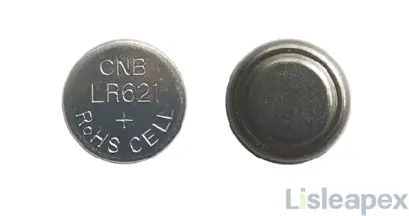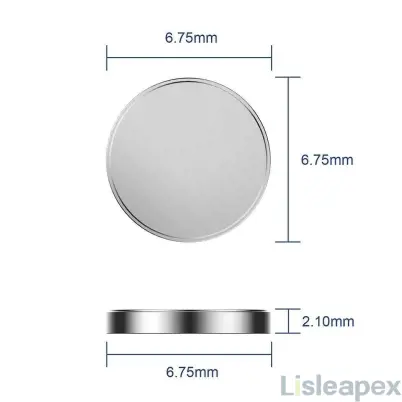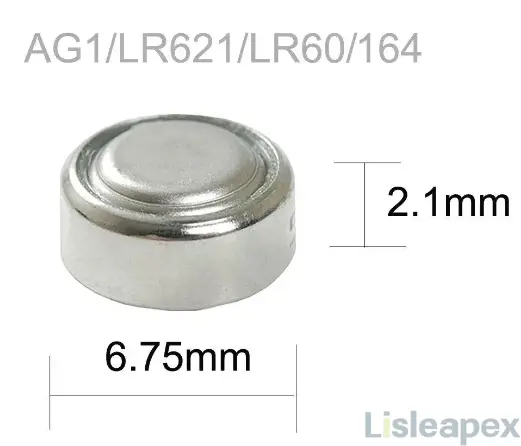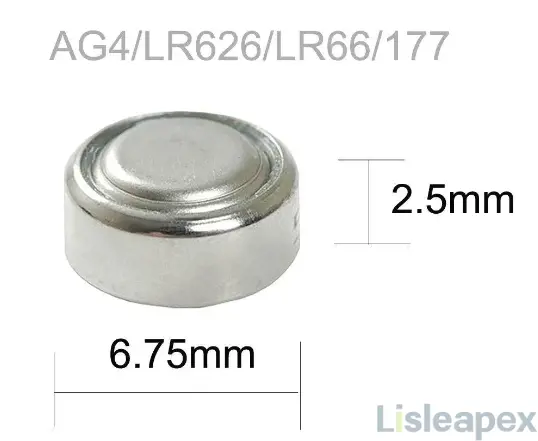Button cell batteries, such as the AG1 battery, are indispensable power sources for a myriad of small electronic devices that we use in our daily lives. With their compact size and reliable performance, these batteries ensure uninterrupted operation for devices ranging from watches and calculators to toys and medical instruments. Among these, the AG1 battery stands out for its versatility and dependability, offering users a choice between alkaline and silver oxide chemistries to suit their specific device requirements.
Let's delve deeper into the world of button cell batteries and explore the unique features and applications of the AG1 battery.
Introduction to AG1 Battery
The AG1 battery, also known as the LR621 battery, belongs to the category of small coin cell batteries. It is available in both alkaline and silver oxide versions, with the latter often labeled as SR621SW. Silver oxide variants are renowned for their superior stability in voltage output and longer lifespan compared to the alkaline counterparts, which are denoted as LR621 or AG1.

The AG1 battery boasts a compact form factor, with a diameter of 6.8 mm and a height of 2.1 mm. LR44 batteries, which are similar in size, typically operate at 1.5 volts and maintain an operating temperature range of 0°C to 60°C, with an optimal temperature of 20°C.
Due to its diminutive size and dependable performance, the AG1 battery finds widespread use in various applications. It is a staple power source in watches, small electronic devices such as calculators, laser pointers, toys, and certain medical devices.
1) What is Button Cell Battery
A button cell battery, also known as a coin cell battery, is a small, round, and flat battery that resembles a coin or button. It typically has a diameter ranging from 5 to 25 millimeters and a thickness of 1 to 6 millimeters. These batteries are commonly used in small electronic devices where space is limited, such as watches, calculators, remote controls, hearing aids, and electronic toys.
Button cell batteries come in various chemistries, including alkaline, silver oxide, lithium, and zinc-air. Each chemistry offers different voltage outputs, capacities, and shelf lives, making them suitable for different applications.
Due to their compact size and reliability, button cell batteries are popular for powering devices that require low to moderate power consumption and where long-term reliability is essential. They are often sealed in a metal casing to prevent leakage and are designed for single-use or rechargeable applications, depending on the chemistry.
2) What does AG stand for in Watch Batteries
In watch batteries, "AG" typically stands for "Alkaline Battery, Mercury-Free." The "AG" designation is a part of the naming convention for button cell batteries, where each letter and number represents specific characteristics of the battery. For example:
- A: Denotes the chemistry of the battery, in this case, alkaline.
- G: Represents the shape and size of the battery. In the case of AG batteries, it usually indicates a cylindrical shape.
So, in the context of watch batteries, "AG" signifies that the battery is alkaline and is designed for use in watches and other small electronic devices.
AG1 Battery Specification

|
Specification |
Details |
|
Chemistry |
Alkaline (LR621) or Silver Oxide (SR621SW) |
|
Voltage |
1.5 volts (Alkaline), 1.55 volts (Silver Oxide) |
|
Diameter |
Approximately 6.8 mm |
|
Height |
Approximately 2.1 mm |
|
Weight |
Approximately 0.28 grams |
|
End Point Voltage |
0.9 volts |
|
Storage Humidity |
60±15%RH (no condensate) |
|
Capacity |
9mAh (varies by manufacturer and application, with Silver Oxide typically offering higher capacity) |
Features of AG1 Battery
- Chemistry Options: Available in both Alkaline (LR621) and Silver Oxide (SR621SW) variants to suit different device requirements.
- Voltage: Offers a standard voltage of 1.5 volts for alkaline and 1.55 volts for silver oxide, ensuring compatibility with a wide range of electronic devices.
- Compact Size: With a diameter of approximately 6.8 mm and a height of approximately 2.1 mm, the AG1 battery is compact, making it suitable for small electronic devices.
- Lightweight: Weighing only about 0.28 grams, it provides power without adding significant weight to the device.
- Stable Performance: Maintains a stable voltage output throughout its lifespan, ensuring consistent and reliable power supply to devices.
- Long Shelf Life: Can be stored under specified humidity conditions (60±15%RH) without condensation, retaining its performance for extended periods.
- Wide Range of Applications: Ideal for various small electronic devices such as watches, small calculators, hearing aids, laser pointers, and some medical devices like digital thermometers.
- Compatibility: Compatible with other battery codes including LR60, 164, LR621 for alkaline versions, and 364, SR621SW for silver oxide versions, offering flexibility in device usage and replacement.
AG1 Battery Equivalent Part
AG1 batteries come in two main chemistry types: alkaline and silver oxide. The choice between these two options depends on the specific requirements of the device being powered.
Alkaline Batteries: These are commonly used for low-drain devices. They offer a lower initial cost and are suitable for devices with less demanding power needs. Alkaline batteries are ideal for devices like remote controls, flashlights, and low-power toys.
Silver Oxide Batteries: Silver oxide batteries are typically used in devices with higher power requirements and where stable voltage output is critical. They offer a longer lifespan and more stable voltage, making them suitable for precision instruments such as watches, calculators, and medical devices.
Now, let's list the equivalent parts for the AG1 battery:
- Alkaline Equivalents: LR60, 080-D29, G1A, L621, LR620, LR621, LR621W
- Silver Oxide Equivalents: 164, 364/363, CX60, D364, E364, GP364, S621E, SA621SW, SB-DG, SB-AG, SG1, SP364, SR60, SR60L, SR620SW, SR621 (muRata SR621), SR621SW, SR621W (Maxell SR621SW, Seiko SR621SW), V364, V531, W1V, 364A, 364B
Application & Uses
Watches: AG1 batteries serve as a reliable power source for a wide range of watches, including analog, digital, and quartz watches. Their compact size and stable voltage output make them ideal for timekeeping devices.
Calculators: In small electronic devices like calculators, AG1 batteries provide the necessary power for calculations and other functions. Their long-lasting performance ensures uninterrupted usage in educational, professional, and personal settings.
Laser Pointers: AG1 batteries are commonly used to power laser pointers, which find applications in presentations, lectures, demonstrations, and various professional environments. The consistent voltage output of AG1 batteries ensures reliable laser performance.
Toys: Many electronic toys, such as miniature gadgets, electronic games, and interactive toys, rely on AG1 batteries for power. These batteries enable hours of entertainment and playtime for children and adults alike.
Medical Devices: AG1 batteries are utilized in certain medical devices, including digital thermometers, glucose meters, and other portable medical instruments. Their compact size, stable power output, and long shelf life make them suitable for healthcare applications.
Key Fobs: AG1 batteries power key fobs for cars, remote controls for electronics, and other similar devices. Their small size allows for seamless integration into keychain accessories while providing reliable power for remote operation.
LED Lights: Some small LED lights, such as those used for keychains or emergency lighting, are powered by AG1 batteries. These batteries ensure consistent illumination in compact lighting solutions for everyday carry or emergency situations.
Electronic Devices: AG1 batteries are employed in various other small electronic devices, including small flashlights, electronic jewelry, remote controls for electronics, and miniature electronic gadgets. Their versatility and reliability make them indispensable power sources for numerous consumer electronics.
AG1 vs AG4: Differences between AG1 and AG4 Battery
The AG1 and AG4 batteries, both commonly known as LR621 and LR626 respectively, serve as compact button cell batteries suitable for various small electronic devices. While they share similarities in chemistry and nominal voltage, they exhibit differences in size, capacity, and applications. AG1 batteries, with a diameter of approximately 6.8 mm and a height of 2.1 mm, are smaller and typically used in devices with lower power requirements, such as watches and calculators. On the other hand, AG4 batteries, slightly larger with a height of 2.6 mm, offer higher capacity and are suitable for devices that demand slightly more power and longer life, including watches, small toys, and some medical devices.


AG1 vs AG4:
|
Feature |
AG1 Battery |
AG4 Battery |
|
Chemistry |
Alkaline or Silver Oxide |
Alkaline or Silver Oxide |
|
Voltage |
1.5 volts (Alkaline), 1.55 volts (Silver Oxide) |
1.5 volts (Alkaline), 1.55 volts (Silver Oxide) |
|
Diameter |
Approximately 6.8 mm |
Approximately 6.8 mm |
|
Height |
Approximately 2.1 mm |
Approximately 2.6 mm |
|
Capacity |
Varies depending on chemistry and manufacturer |
Typically higher, especially in Silver Oxide versions |
|
Applications |
Watches, calculators, small electronic devices |
Watches, small toys, some medical devices |
Conclusion
In conclusion, the AG1 battery remains a vital component in the realm of small electronics, providing a compact yet powerful energy solution for a diverse range of devices. Whether it's powering your wristwatch, calculator, or favorite electronic toy, the AG1 battery ensures consistent performance and reliable power delivery. With its compact form factor, stable voltage output, and compatibility with various devices, the AG1 battery continues to play a crucial role in powering our everyday gadgets, making it an essential part of modern life.
Related Post:
CR1620 vs CR1632: What are Differences and How to Choose
CR2430 vs CR2450:What are Differences and Are They Interchangeable
FAQ
-
What is the voltage of an AG1 battery?
An AG1 battery typically has a nominal voltage of 1.5 volts.
-
What are the dimensions of an AG1 battery?
An AG1 battery has a diameter of approximately 6.8 mm and a height of about 2.1 mm.
-
What is the typical capacity of an AG1 battery?
The capacity of an AG1 battery is typically around 12 to 15 mAh, depending on the manufacturer and the specific chemistry used.
-
What chemistries are AG1 batteries available in?
AG1 batteries are available in alkaline (LR621) and silver oxide (SR621SW) chemistries. Silver oxide batteries usually have a longer lifespan and more stable voltage output compared to alkaline batteries.
-
Are AG1 batteries interchangeable with other batteries?
Yes, AG1 batteries can often be interchanged with other batteries that have the same physical dimensions and similar voltage, such as LR621, 164, and SR621SW. However, the performance and lifespan may vary depending on the specific chemistry.
-
What are the safety precautions for handling AG1 batteries?
Handle AG1 batteries with care to avoid short-circuiting, puncturing, or exposing them to extreme temperatures. Keep them out of reach of children and pets, as swallowing button cells can be dangerous and requires immediate medical attention.
Stay updated with Lisleapex by signing up for the newsletter


 Congratulations On Your Successful Submission
Congratulations On Your Successful Submission
 Submission Failure
Submission Failure